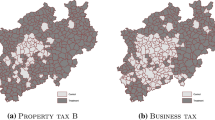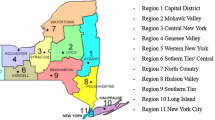Abstract
This paper analyzes the effect of Walmart and Target on municipal property tax rates using panel data for all New Jersey municipalities from 1998 to 2007. We analyze the impact of Walmart (30 openings) and Target (33 openings) in the host municipality and the nearest adjacent municipality. We find evidence that entry by either retailer lowers the tax rate in the host municipality. However, the estimated reduction in the tax rate is much larger for Target. Target entry reduces the equalized property tax rate by $0.38 per $100 of market value in the host municipality or about 16.8 % while Walmart reduces the equalized property tax rate in the host municipality by $0.063 per $100 of market value or about 2.8 %. The most striking result is the contrast between the positive and significant effect of Walmart entry on the equalized tax rate in the adjacent municipality and the negative and significant effect of Target entry on the equalized tax rate in the adjacent municipality. Walmart entry (in the host municipality) raises the equalized tax rate by about $0.23 per $100 of market value (about a 10 % increase). Target entry, on the other hand, reduces the equalized tax rate in the adjacent municipality by $0.14 per $100 of market value or about 6.2 %.
Similar content being viewed by others
Notes
Vandegrift and Loyer (2015) provides a detailed review of this literature.
For more details, see Vandegrift and Loyer (2015).
Control variables include: population, growth in population, population density, growth in the residential to total tax base ratio, ratio of the residential tax base to the total tax base, equalized tax base per acre, growth in the equalized tax base, the equalized tax rate, normalized standardized language test scores, growth in normalized standardized language test scores, distance to the Atlantic coast, the number of major intersections, and the percentage of land classified as wetlands.
See Vandegrift and Loyer (2015) for more details.
We do not report these estimates in the paper. These estimates are not informative because the first-stage fitted values are highly correlated with the independent variables.
Terza et al. (2008) show that 2SRI outperforms t (i.e., using the predicted values of the endogenous variable from the first stage in the second stage equation).
Language test scores and math test scores are highly correlated across high schools and therefore adding math test scores does not improve the quality of the estimates.
Driscoll and Kraay (1998) construct a covariance matrix estimation technique for panel data. The technique produces standard error estimates that are robust to general forms of spatial and temporal dependence.
Column 2: F = 0.04, p = 0.84; column 4: F = 0.23, p=0.63; column 6: F = 0.05, p = 0.82; column 7: F = 0.20, p = 0.65; column 8: F = 0.83, p = 0.44.
A review of newspaper articles indicates that, at times, Walmart will pay transportation impact fees for road improvements. However, it is unclear how often Walmart makes such payments.
References
Angrist, J., Pischke, J.: Mostly Harmless Econometrics: An Empiricist’s Companion. Princeton University Press, Princeton (2009)
Artz, G., McConnon, J.: The impact of Wal-Mart on host towns and surrounding communities in Maine. paper presented at the Northeast Agricultural and Resource Economics Association Meetings, Bar Harbor, ME (2001)
Artz, G., Stone, K.: Analyzing the impact of Wal-Mart supercenters on local food store sales. Am. J. Agric. Econ. 88, 1296–1303 (2006)
Basker, E.: Selling a cheaper mousetrap: Wal-Mart’s effect on retail prices. J. Urban Econ. 58, 203–229 (2005a)
Basker, E.: Job creation or destruction? labor market effects of Wal-Mart expansion. Rev. Econ. Stat. 87, 174–183 (2005b)
Basker, E.: The causes and consequences of Wal-Mart’s growth. J. Econ. Perspect. 21, 177–198 (2007)
Boarnet, M., Crane, R.: The impact of big-box grocers on Southern California: jobs, wages, and municipal finances. Report to the Orange County Business Council (1999)
Carden, A., Courtmanche, C., Meiners, J.: Does Wal-Mart reduce social capital? Public Choice 138, 109–136 (2009)
Cotton, B., Cachon, J.: Resisting the giants: small retail entrepreneurs against mega retailers—an empirical study. J. Small Bus. Entrep. 20, 135–150 (2007)
Driscoll, J., Kraay, A.: Consistent covariance matrix estimation with spatially dependent panel data. Rev. Econ. Stat. 80, 549–560 (1998)
Global Insight: The economic impact of Wal-Mart. research report. http://www.ihsglobalinsight.com/publicDownload/genericContent/11-03-05_walmart.pdf (2005)
Goetz, S., Rupasingha, A.: Wal-Mart and social capital. Am. J. Agric. Econ. 88, 1304–1310 (2006)
Goetz, S., Swaminathan, H.: Wal-Mart and county-wide poverty. Soc. Sci. Q. 87, 211–226 (2006)
Gscottschneider, R.: Understanding the Tax Base Consequences of Local Economic Development Programs. RKG Associates, Inc, Dover (1998)
Haltiwanger, J., Jarmin, R., Krizan, C.: Mom-and-pop meet big-box: complements or substitutes? J. Urban Econ. 67, 116–134 (2010)
Hausman, J., Leibtag, E.: Consumer benefits from increased competition in shopping outlets: measuring the effect of Wal-Mart. J. Appl. Econom. 22, 1157–1177 (2007)
Hicks, M., Wilburn, K.: The regional impact of Wal-Mart entrance: a panel study of the retail trade sector in West Virginia. Rev. Reg. Stud. 31, 305–313 (2001)
Hicks, M.: Wal-Mart’s impact on local revenue and expenditure instruments in Ohio, 1988–2003. Atlantic Econ. J. 35, 77–95 (2007)
Hicks, M.: Estimating Wal-Mart’s impacts in Maryland: a test of identification strategies and endogeneity tests. Eastern Econ. J. 33, 56–73 (2008)
Hicks, M.: Wal-Mart and small business: boon or bane? Rev. Reg. Stud. 39, 73–83 (2009)
Hicks, M.: Does Wal-Mart cause an increase in anti-poverty program expenditures? Soc. Sci. Quart. 96, 1136–1152 (2015)
Muller, T., Humstone, E.: What Happened When Wal-Mart Came to Town? A Report on Three Iowa Communities with a Statistical Analysis of Seven Iowa Counties. National Trust for Historic Preservation, Washington, D.C (1996)
Neumark, D., Zhang, J., Ciccarella, S.: The effects of Wal-Mart on local labor markets. J. Urban Econ. 63, 405–430 (2008)
Newey, W.: Semiparametric efficiency bounds. J. Appl. Econom. 5, 99–135 (1990)
Noss, A.: Household income: 2013 American Community Survey Briefs, Washington DC, Census Bureau (2014). https://www.census.gov/content/dam/Census/library/publications/2014/acs/acsbr13-02.pdf
Paruchuri, S., Baum, J., Potere, J.: The Wal-Mart effect: wave of destruction or creative destruction? Econ. Geogr. 85, 209–236 (2009)
Pope, D., Pope, J.: When Walmart comes to town: always low prices? Always? J. Urban Econ. 87, 1–13 (2015)
Stone, K.: Impact of the Wal-Mart phenomenon on rural communities. In: Proceedings of increasing understanding of public problems and policies—1997. Chicago, Farm Foundation (1997)
Terza, J., Basu, A., Rathouz, P.: Two-stage residual inclusion estimation: addressing endogeneity in health econometric modeling. J. Health Econ. 27, 531–543 (2008)
Vandegrift, D., Loyer, J.: The effect of Walmart and Target on the tax base: evidence from New Jersey. J. Reg. Sci. 55, 159–187 (2015)
Walczak, J.: How high are property taxes in your state? Washington DC, Tax Foundation (2015). http://taxfoundation.org/blog/how-high-are-property-taxes-your-state
Author information
Authors and Affiliations
Corresponding author
Additional information
The author would like to thank John Loyer for compiling data in support of the analysis and two anonymous referees for helpful comments.
Rights and permissions
About this article
Cite this article
Vandegrift, D. The effect of Walmart and Target on property tax rates. Lett Spat Resour Sci 9, 309–327 (2016). https://doi.org/10.1007/s12076-015-0159-x
Received:
Accepted:
Published:
Issue Date:
DOI: https://doi.org/10.1007/s12076-015-0159-x




